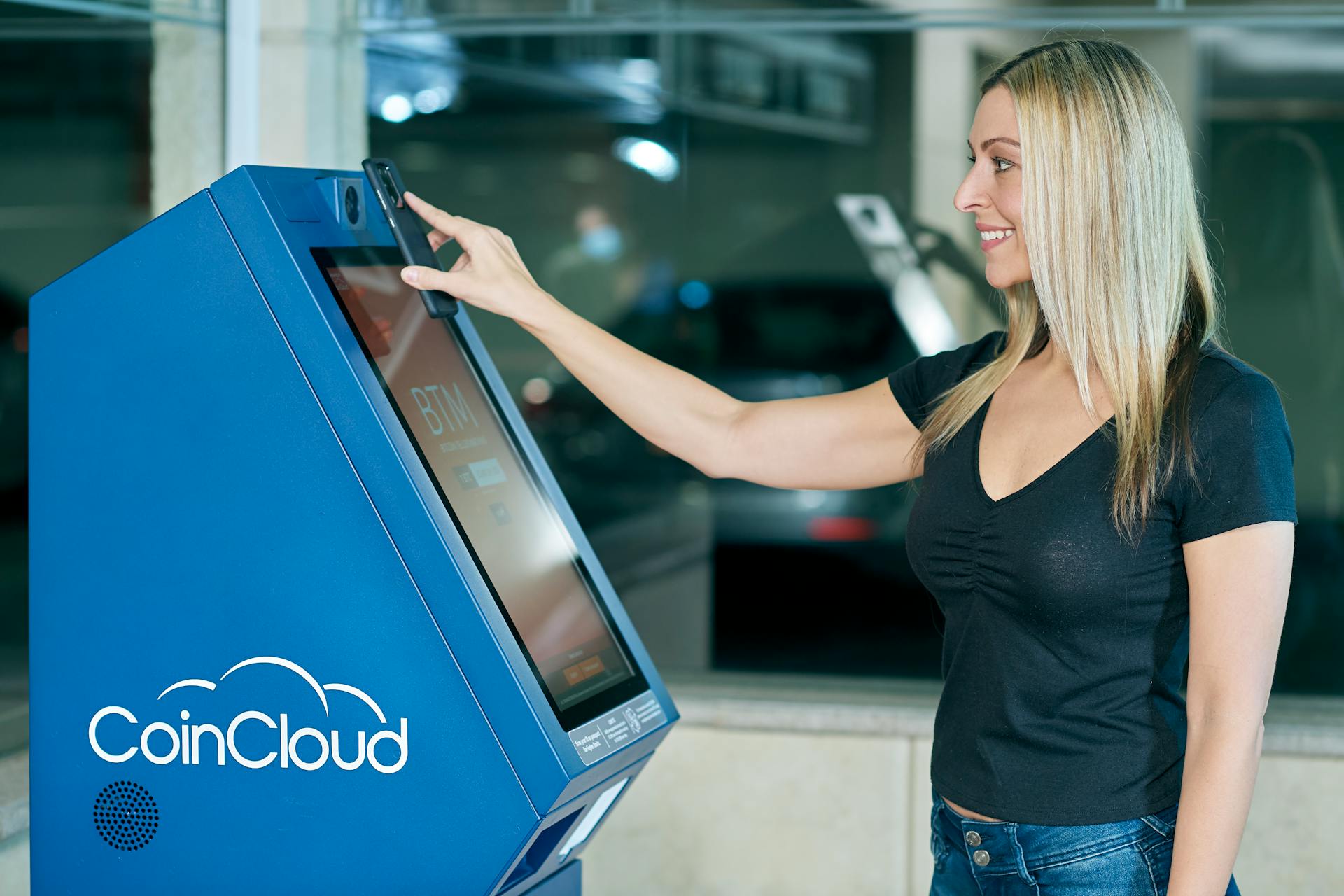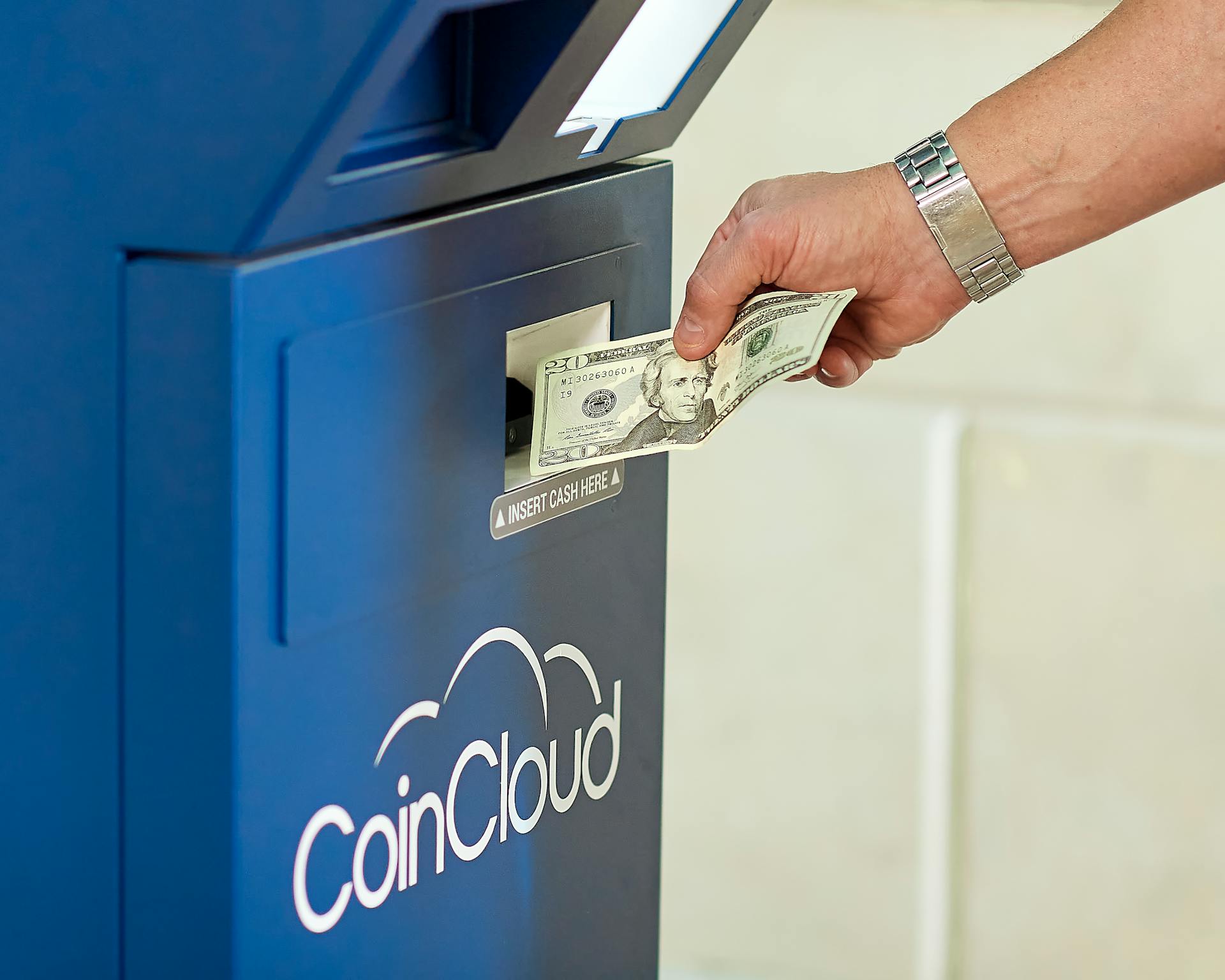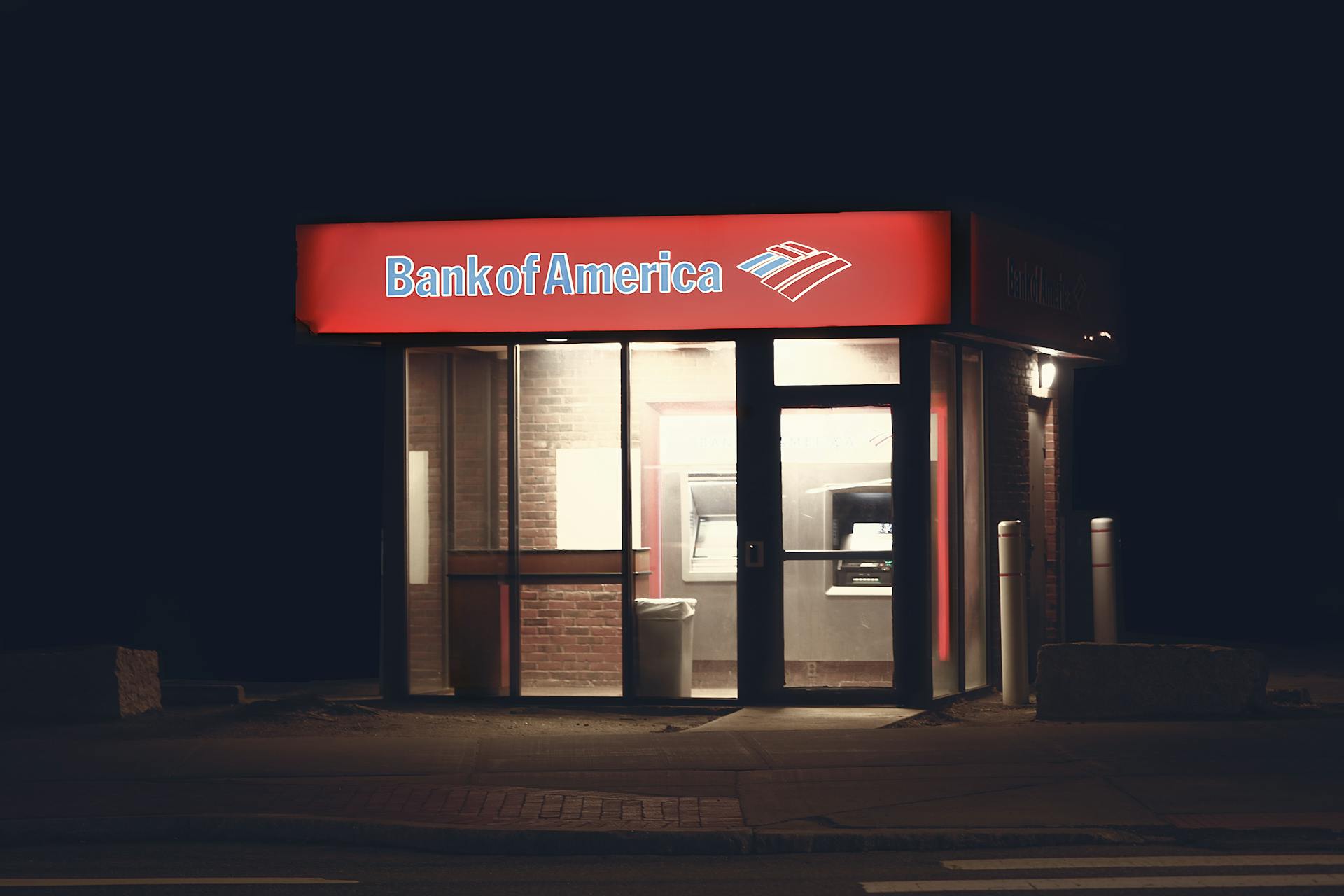
A prepaid ATM card is a type of debit card that allows you to load funds onto it before using it to make purchases or withdraw cash from an ATM. This card is essentially a cashless alternative to cash, and it's a great option for people who want to manage their expenses.
You can use a prepaid ATM card to make purchases online, in-store, or at a restaurant, just like you would with a regular debit card. The funds on your card are deducted automatically, so you can keep track of your spending easily.
To use a prepaid ATM card, you'll need to load funds onto it first, which can be done online or at a participating retailer. Once you've loaded funds, you can use your card to make purchases or withdraw cash from an ATM.
Expand your knowledge: Capital One 360 Wire Fees
What is a Prepaid ATM Card?
A prepaid ATM card is a type of debit card that allows users to load funds onto the card before using it to make purchases or withdraw cash.
These cards are typically issued by banks or financial institutions and can be used to make transactions online, in-store, or at ATMs.
Prepaid ATM cards can be loaded with funds using various methods, such as direct deposit, bank transfers, or even cash reloads at participating retailers.
Some prepaid cards come with fees, such as monthly maintenance fees or ATM withdrawal fees, which can range from $2 to $5 per transaction.
Other prepaid cards may offer rewards or cashback on certain purchases, but these benefits often come with specific requirements or restrictions.
Prepaid ATM cards can be a good option for people who want to control their spending or have limited credit history, as they don't require a credit check to apply.
Pros and Cons
Prepaid ATM cards offer a convenient way to manage your finances without a traditional bank account. You can make purchases online and perform other banking functions with a prepaid debit card.
One of the main advantages of prepaid debit cards is that you don't need to pass a credit check to get one. This makes them a great option for people with bad credit or those who have been rejected by banks in the past.
However, prepaid debit cards can come with fees that add up quickly. Be sure to shop around for the best deal and understand what fees you're paying.
With a prepaid debit card, you can only spend the money you put on your card balance, which means you can't overspend and incur an overdraft fee. This can help you avoid debt and stay on top of your finances.
On the other hand, using a prepaid debit card doesn't help you build credit since your spending isn't reported to credit bureaus. If you're trying to improve your credit score, a prepaid debit card might not be the best choice.
Here are some common fees associated with prepaid debit cards:
Using a Prepaid ATM Card
You can use a prepaid ATM card at any ATM that supports your card's network, such as Visa or Mastercard. This means you can withdraw cash from your card's balance at over 900,000 ATMs worldwide.
Prepaid ATM cards can be used at ATMs to withdraw cash, check your balance, and even deposit money. However, some card issuers may charge fees for these services.
To use a prepaid ATM card, you'll need to activate it first, which may involve registering your personal information, such as your name, address, and Social Security number. This adds an extra layer of security to your card.
Here are some things to keep in mind when using a prepaid ATM card:
- Make sure to check your card's balance before making a withdrawal or purchase.
- Be aware of any fees associated with using your card at ATMs, both domestically and internationally.
- Keep your card information secure to prevent unauthorized transactions.
Verify Identity and Provide Documentation
To use a prepaid ATM card, you'll need to verify your identity and provide necessary documentation. This is a crucial step to get your prepaid card.
You'll need to provide valid proof of identity, such as a driver's license or passport, and proof of your home or office address. This is required for Know Your Customer (KYC) purposes, as stated in Example 5.
Some prepaid card issuers may require you to register your card with personal information like your name, address, and Social Security number, as mentioned in Example 2. This adds an extra layer of security for accessing features like reloading the card or using an ATM.
To verify your identity, you may need to provide documentation, such as a utility bill or lease agreement, to prove your address. This is a common requirement for many prepaid card issuers.
Here's a list of common documents you may need to provide:
- Driver's license or passport (proof of identity)
- Utility bill or lease agreement (proof of address)
- Valid government-issued ID (proof of identity)
Remember, the specific documentation requirements may vary depending on the prepaid card issuer and the type of card you're applying for. Be sure to check with the issuer to confirm their requirements.
Where to Use
You can use a prepaid ATM card anywhere traditional Visa debit cards are accepted, including online retailers, brick-and-mortar stores, gas stations, grocery stores, restaurants, and ATMs.
To give you a better idea of where you can use your prepaid ATM card, here are some specific locations:
- Online retailers
- Brick-and-mortar stores
- Gas stations
- Grocery stores
- Restaurants
- ATMs
Some prepaid cards, like the Mango Prepaid Mastercard, can even be used at any ATM that supports Mastercard worldwide, giving you the freedom to make payments and withdrawals globally.
Additional reading: Alberta Treasury Branch Mastercard
Using to Save
Using a prepaid ATM card can be a great way to save money. You can have an automatic method of saving money by loading a specific amount onto the card each month.
A prepaid ATM card can help you avoid overspending by only allowing you to spend what's available on the card. This can be a huge help if you tend to splurge or get caught up in impulse purchases.
One of the benefits of prepaid debit cards is that there are no overdraft fees. This means you can't accidentally spend more than you have, which can save you a lot of money in fees.
You can also use a prepaid debit card to pay bills, which can help you stay on top of your finances. This can be especially helpful if you have bills that are due at different times of the month.
Here are some benefits of using a prepaid debit card for saving:
- No overdraft fees
- No monthly account minimums
- No credit checks
- A safe alternative to carrying cash
By using a prepaid ATM card, you can take control of your spending and start saving money.
Security and Fees
You'll want to pay close attention to the fees associated with your prepaid card. According to the Consumer Financial Protection Bureau (CFPB), you may be charged fees for reasons like withdrawing cash, making purchases, reloading your card, and checking the balance on your card.
Some common fees to expect include fees for withdrawing cash, making foreign transactions, and not using your card for a certain amount of time. These fees can add up quickly, so it's essential to factor them into your decision.
To minimize fees, look for prepaid cards with low fees or no fees at all. You can also consider cards that offer free ATM withdrawals at a large network of locations near you.
Here are some common fees to watch out for:
- Withdrawing cash
- Making foreign transactions
- Not using your card for a certain amount of time
- Reloading your card
- Checking the balance on your card
- Transferring money between cards
Security Measures
Having a prepaid card can be a great way to manage your expenses, but it's essential to ensure your card provider has robust security measures in place.

These measures protect your prepaid card details from unauthorized access, safeguarding your money.
In fact, some card providers offer real-time value for money, which means you can track your spending and stay on top of your finances.
This can be especially helpful if you're trying to stick to a budget or avoid overspending.
To maximize the benefits of your prepaid card, make sure your provider has robust security measures to prevent unauthorized access and protect your money.
See what others are reading: Earned Wage Access Providers
Multiple Fees
Multiple fees are a common aspect of prepaid cards. You may be charged fees for various reasons.
One of the reasons you may be charged a fee is for withdrawing cash. According to the Consumer Financial Protection Bureau (CFPB), this can happen.
You may also be charged a fee for making purchases. This is a common practice among prepaid card issuers.
Another reason you may be charged a fee is for reloading your card. This can happen if you need to add more funds to your card.
Checking the balance on your card can also incur a fee. This is something to consider when choosing a prepaid card.
Transferring money between cards can also result in a fee. This is worth keeping in mind when managing your prepaid card.
Not using your card for a certain amount of time can also lead to a fee. This is a common practice among prepaid card issuers.
Making foreign transactions can also incur a fee. This is something to consider when traveling abroad.
Using your card every month can also result in a fee. This is a common practice among prepaid card issuers.
Here's a summary of the fees you may be charged:
- Withdrawing cash
- Making purchases
- Reloading your card
- Checking the balance on your card
- Transferring money between cards
- Not using your card for a certain amount of time
- Making foreign transactions
- Using your card every month
Credit
Building credit is a crucial step in financial stability, but it can be challenging to establish a good credit history from scratch. You can't build credit with a prepaid card because it's not linked to a line of credit.
To establish credit, consider applying for a traditional credit card, which is linked to a line of credit. If that's not an option, you can apply for a secured credit card as an alternative.
Secured credit cards can be a good option for those who want to build credit, but they often require a security deposit to open the account. You can use the money you've loaded onto a prepaid card to make a security deposit for a secured credit card.
Suggestion: Ebt Card Not Working at Atm
Choosing a Prepaid ATM Card
Choosing a prepaid ATM card involves considering several key factors. You'll want to find out what fees you'll have to pay and compare multiple cards to find the one with the lowest fees.
To ensure convenience, look for a card with a large ATM network at locations near you. It's also essential to find a card that's free to use at the ATM. Some prepaid cards charge high fees for out-of-network ATM withdrawals.
Here are some essential features to consider when choosing a prepaid ATM card:
When Choosing
When choosing a prepaid ATM card, it's essential to do your due diligence and research different providers. This means studying each card's benefits, fees, terms of use, and other features to inform your decision.
When shopping around, consider what fees you'll have to pay and compare multiple cards to find the one with the lowest fees. It's also crucial to ensure the card has a large ATM network at locations near you.
To avoid surprise fees, look for a card with a large network of ATMs close to you with fee-free options. This can save you money and hassle in the long run.
When evaluating a "no fee" prepaid debit card, consider the following factors:
- A large network of ATMs close to you with fee-free options
- Fee-free purchases (online and in-person)
- Fee-free bill payments
- No minimum balance requirements
- No monthly or annual fees for using your prepaid card
Some prepaid Visa debit cards, like the MyVanilla Prepaid Visa Card, don't charge a monthly fee and allow direct deposit of your paycheck. Others, like the Green Dot Reloadable Prepaid Visa Card, may waive the $7.95 monthly fee if you load $1,000 or more in the previous month.
Debit vs Credit
A debit card is linked to a bank account, which means you can draw from your account balance to make purchases. You'll need to have enough money in your account to cover transactions.
Unlike credit cards, debit cards don't draw from a line of credit, so you're not borrowing money. This can be a relief for those who tend to overspend.
Debit cards are often associated with checking accounts, which can be a convenient way to manage your finances. However, prepaid cards can be a better option for those who want to separate their spending money from their everyday account.
Unlike credit cards, prepaid debit cards are not linked to a line of credit, so you're not building credit or incurring interest charges. This can be a more budget-friendly option for those who want to stick to their spending limits.
If you're looking to establish credit, a traditional credit card might be a better choice. But if you're looking for a simple, no-frills option, a prepaid debit card could be the way to go.
Related reading: Prepaid Card Not Work for Recurring Payments
Netspend
The Netspend Visa Prepaid Card offers unlimited transactions for a flat monthly fee, making it a great option for frequent users.
You can use this card many times a month without paying extra fees, which is a big plus.
However, be aware that the local ATM withdrawal fee is quite high, though it still follows industry standards.
This card also charges an inactivity fee after 90 days of no transaction, so make sure to use it regularly.
To reduce your monthly payment, you can meet direct deposit requirements and halve your fee, which is a nice perk.
Keep in mind that you'll need to activate and verify your ID before you can use this preloaded card.
Bluebird American Express Account
The Bluebird American Express Account is a great option for those who want a prepaid debit card with flexibility.
It's a reloadable prepaid debit account that can be used anywhere American Express cards are accepted.
One of its standout features is free ATM access at a relatively low rate.
This account also doesn't charge a fee for ATM balance inquiries or declined ATM transactions.
Another perk is that it imposes no inactivity fee, so you don't have to worry about being penalized for not using it.
You might enjoy: History of American Express Company
Frequently Asked Questions
How do I put money on a prepaid card?
You can add funds to a prepaid card by depositing money from a checking account, paychecks, or other regular income, or by reloading it with cash at a retail location or bank. To get started, explore the various options for adding money to your prepaid card.
Sources
- https://www.creditkarma.com/money/i/how-do-prepaid-visa-debit-cards-work
- https://www.capitalone.com/learn-grow/money-management/how-do-prepaid-debit-cards-work/
- https://www.truelinkfinancial.com/prepaid-card
- https://www.mywisely.com/financial-wellness/prepaid-debit-cards-better-manage-money/
- https://prestmit.io/blog/unveiling-5-prepaid-cards-with-convenient-atm-access-a-comprehensive-guide
Featured Images: pexels.com


